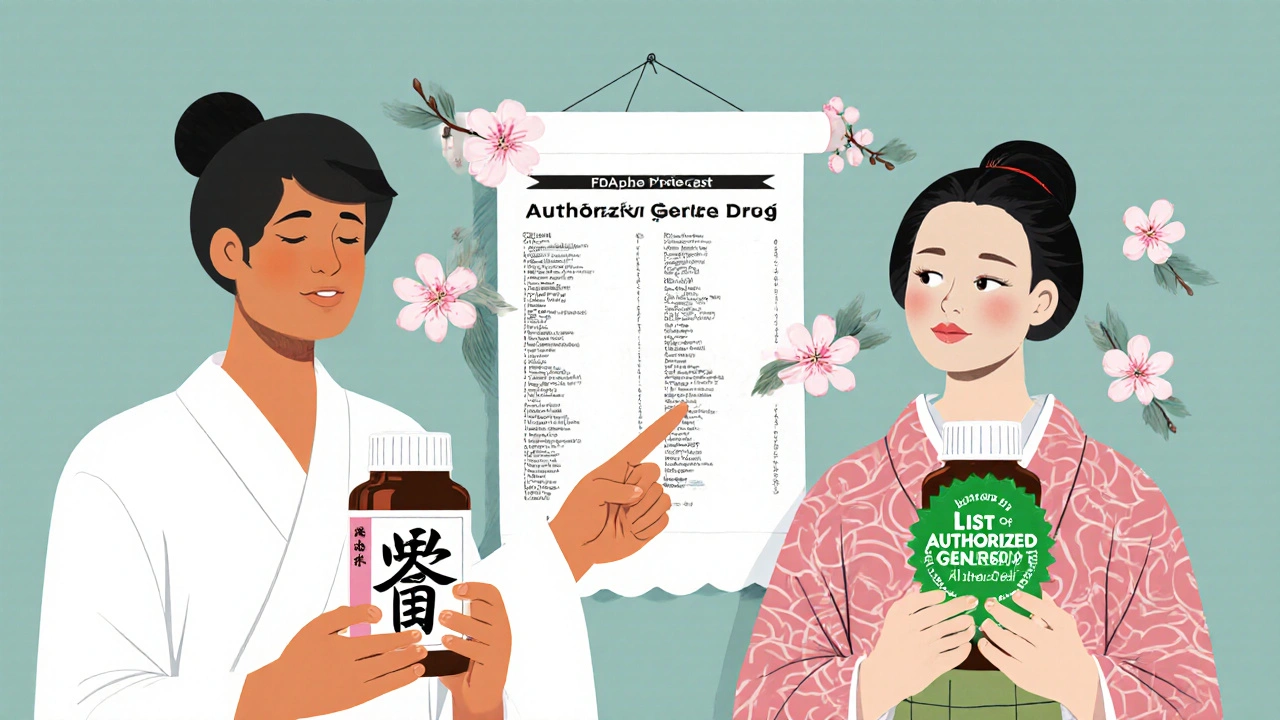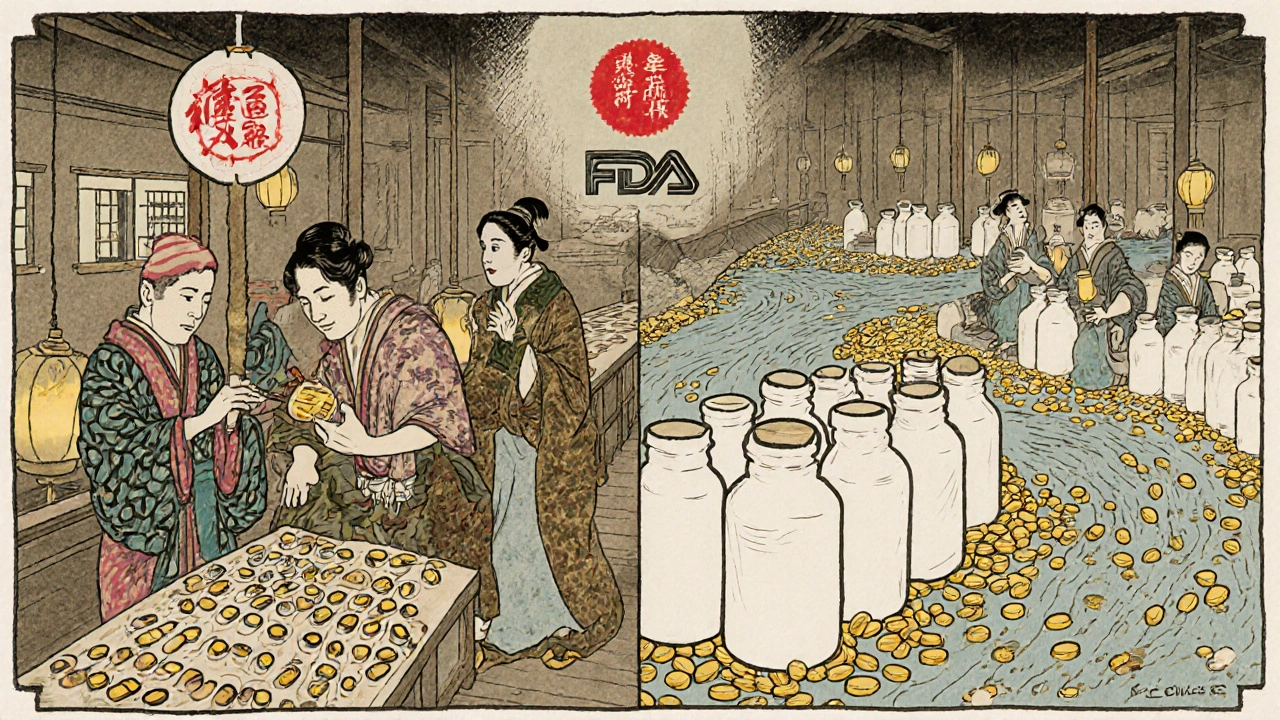
When you pick up a prescription, you might see a different name on the bottle than what your doctor wrote. That’s not a mistake. It could be a generic drug - and not just any generic. There’s a type called an authorized generic, and it’s not what most people think it is. Many patients assume all generics are the same. They’re not. Understanding the difference between an authorized generic and a traditional generic can save you money, avoid side effects, and give you more control over your treatment.
What Is an Authorized Generic?
An authorized generic is the exact same medication as the brand-name drug you’re used to - down to the last ingredient. The only difference? It doesn’t have the brand name on the label. It’s made by the same company that makes the brand-name version, or by a partner they’ve approved. The FDA calls it a "listed drug" that’s sold without the brand’s trademark, packaging, or color. Think of it like buying a Coca-Cola bottle with the logo removed. The liquid inside is identical.Authorized generics don’t go through the usual generic approval process. Instead, they use the original brand’s New Drug Application (NDA). That means no extra testing, no bioequivalence studies, no waiting. If the brand drug works, the authorized generic works the same way - because it’s the same product.
These aren’t new. They’ve been around since the 1980s, after the Hatch-Waxman Act created the pathway for traditional generics. But they’ve grown fast. As of September 2023, there were 1,872 authorized generic products in the U.S., covering 467 different active ingredients. Companies like Greenstone (a Pfizer subsidiary), Prasco Laboratories, and Patriot Pharmaceuticals handle most of them.
How Authorized Generics Are Different from Traditional Generics
The confusion starts here. Most people think “generic” means one thing. But there are two types - and they’re not interchangeable.Traditional generics are copies. They must contain the same active ingredient, strength, dosage form, and route of administration as the brand. But they can - and often do - use different inactive ingredients. That includes fillers, dyes, preservatives, and coatings. These don’t affect how the drug works, but they can affect how your body reacts to it. Some people report stomach upset, rashes, or other side effects with traditional generics that they never had with the brand. That’s because of those extra ingredients.
Authorized generics have the same active AND inactive ingredients. Same manufacturing process. Same tablet shape, same coating, same everything. The only change is the label. That’s why the FDA says: "An authorized generic is NOT a typical generic."
Here’s another big difference: approval.
- Traditional generics need FDA approval through an Abbreviated New Drug Application (ANDA). They must prove they’re bioequivalent - meaning they get into your bloodstream at the same rate and amount as the brand.
- Authorized generics don’t need an ANDA. They’re already approved under the brand’s NDA. No extra studies. No delays.
That also affects where they show up. Traditional generics are listed in the FDA’s Orange Book - the official guide for therapeutic equivalence. Authorized generics? They’re not in there. Because they’re not separate drugs. They’re the brand drug with a new label.
Why Authorized Generics Exist - And Why Companies Use Them
You might wonder: if a company makes a brand drug, why would they also sell a cheaper version of it?It’s a business move. When a brand drug’s patent expires, other companies can make generics. But the original company can launch its own generic version - an authorized generic - right away. That means they can capture part of the generic market before competitors even get started.
This strategy has a name: "authorized generic entry." It’s common. Between 2018 and 2022, 65% of the top 50 brand-name drugs had an authorized generic launched within six months of patent expiration. The goal? To undercut the first generic applicant’s 180-day exclusivity period. That’s the reward given to the first company to challenge a patent and file an ANDA. If the brand company releases its own generic at the same time, the first generic loses its advantage - and the brand keeps more of the market.
Some critics say this delays true competition. The Congressional Research Service found that in 38.5% of cases, authorized generics were launched alongside traditional generics - often suppressing price drops. But for patients, it can mean faster access to lower prices. If your brand drug costs $150 a month, the authorized generic might be $80. The traditional generic? Maybe $60. But if the authorized generic is available before the traditional one, you get a cheaper option sooner.

What Patients Should Know
Most people don’t know the difference between authorized and traditional generics. A 2022 GoodRx survey found that 78% of patients couldn’t tell them apart just by looking at the pill or bottle.But here’s why it matters:
- If you’ve had bad reactions to traditional generics - like nausea, headaches, or skin rashes - an authorized generic might be the solution. Same formula. Same ingredients. Same chance of side effects as the brand.
- Some insurance plans treat authorized generics as brand-name drugs. That means higher copays. Always check with your pharmacy or plan. If you’re paying more for an authorized generic than a traditional one, ask why.
- Pharmacists may not always know the difference. The FDA doesn’t require pharmacies to track authorized generics separately in their systems. That can cause confusion during medication reviews or when switching drugs.
A 2022 survey by the National Community Pharmacists Association found that 67% of independent pharmacists said patients specifically asked for authorized generics when they were available. Patients want consistency. They want to know their medication hasn’t changed - even if the price did.
How to Spot an Authorized Generic
You won’t see "authorized generic" on the bottle. But here’s how to find out:- Ask your pharmacist: "Is this an authorized generic?" They can check the manufacturer and compare it to the brand.
- Look up the manufacturer. If it’s the same company that makes the brand - like Pfizer, AbbVie, or Merck - it’s likely an authorized generic.
- Check the FDA’s List of Authorized Generic Drugs. It’s updated monthly and available on the FDA website. Search by the brand name or active ingredient.
- Compare the pill’s appearance. Authorized generics often look identical to the brand - same shape, color, markings. Traditional generics may look different.
Some authorized generics are sold under the brand’s own label, just without the brand name. Others are sold under a third-party name like "Greenstone" or "Prasco." If you see those names, it’s a strong sign you’re getting an authorized version.

What This Means for Your Health
For most people, traditional generics are safe and effective. But for those with sensitivities - especially to dyes, lactose, or preservatives - the difference matters. If you’ve ever been told, "This generic doesn’t work like the brand," it might not be your body rejecting the drug. It might be your body reacting to a filler.Authorized generics remove that uncertainty. They’re the closest thing to staying on the brand drug - without the brand price. In specialty drugs - like those for multiple sclerosis, cancer, or autoimmune diseases - formulation consistency is critical. Small changes in inactive ingredients can affect absorption, stability, or even safety. That’s why authorized generics are growing fast. IQVIA predicts they’ll make up 15.3% of the U.S. generic drug market by 2027.
The bottom line? Don’t assume all generics are equal. If your doctor prescribes a brand drug, ask if an authorized generic is available. If you’re already on a traditional generic and feel off, ask if switching to the authorized version is an option. You might not need to pay more. You might just need the same drug - with the right label.
Are authorized generics as safe as brand-name drugs?
Yes. Authorized generics are made using the exact same formula, manufacturing process, and quality controls as the brand-name drug. The FDA considers them therapeutically equivalent because they are the same product. The only difference is the label. If you’ve tolerated the brand drug well, you’ll likely tolerate the authorized generic just as well.
Can I switch from a traditional generic to an authorized generic?
Yes, and many people should. If you’ve experienced side effects with a traditional generic - like stomach upset, dizziness, or skin reactions - it may be due to different inactive ingredients. Authorized generics contain the same inactive ingredients as the brand, so switching can eliminate those issues. Talk to your doctor or pharmacist before switching, but it’s generally safe and often recommended.
Why is my insurance charging me more for an authorized generic than a traditional generic?
Some pharmacy benefit managers (PBMs) incorrectly classify authorized generics as brand-name drugs because they’re made by the same company. This can lead to higher copays. If you’re paying more for an authorized generic than a traditional one, ask your pharmacy to reprocess the claim. You can also request a formulary exception from your insurer - since the drug is chemically identical to the brand, it should be covered as a generic.
Are authorized generics listed in the FDA’s Orange Book?
No. Authorized generics are not listed in the FDA’s Orange Book because they’re marketed under the brand’s original New Drug Application (NDA), not through a separate Abbreviated New Drug Application (ANDA). The Orange Book only includes traditional generics that have gone through the ANDA process. To verify an authorized generic, use the FDA’s separate List of Authorized Generic Drugs.
How do I know if my medication is an authorized generic?
Check the manufacturer name on the bottle. If it matches the brand-name manufacturer - like Pfizer, Johnson & Johnson, or AbbVie - it’s likely an authorized generic. You can also search the FDA’s List of Authorized Generic Drugs online using the brand name or active ingredient. If you’re unsure, ask your pharmacist to confirm. They can look up the product code or contact the distributor.
What to Do Next
If you’re on a brand-name drug, ask your pharmacist: "Is there an authorized generic available?" If you’re on a traditional generic and feel it’s not working the same way, ask: "Could this be a different formulation?" Then ask if an authorized version exists.Don’t let confusion cost you money or health. Authorized generics are a real option - and they’re not just cheaper. They’re the same. That’s worth knowing.



3 Comments
So let me get this straight - an authorized generic is just the brand drug with the logo peeled off? That’s wild. I’ve been taking generics for years and never knew this was a thing. Feels like the pharma companies are playing chess while we’re playing checkers.
I had a friend who switched from her brand-name MS med to a generic and started having panic attacks. She thought it was her mind, but it was the dye in the pill. When she found out the authorized version existed, she cried. It’s not just about cost - it’s about your body trusting what you’re putting in it. This post saved her life.
Stop pretending this is about patient care. It’s about profit.